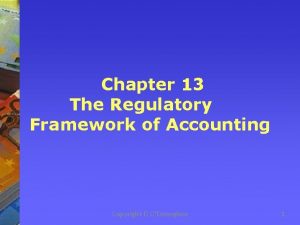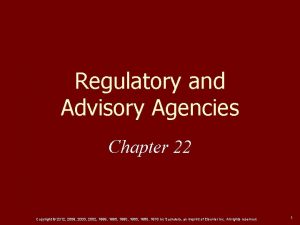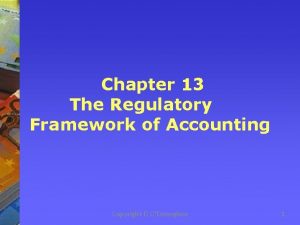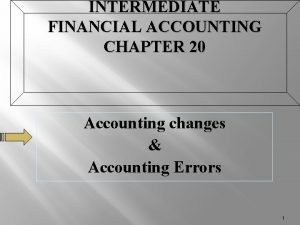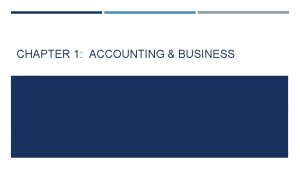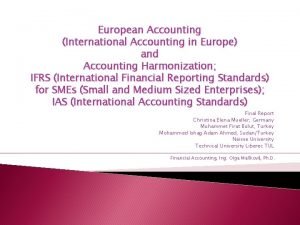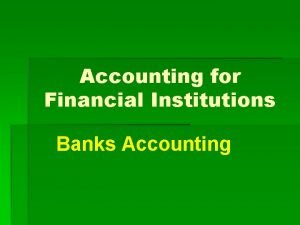Chapter 13 The Regulatory Framework of Accounting Copyright














- Slides: 14

Chapter 13 The Regulatory Framework of Accounting Copyright D O'Donoghue 1

The Regulatory Framework of Accounting Contents: q The purpose of a regulatory framework q The role of Accounting standards q International accounting standards q Accounting Concepts and their role q q q q q Business entity concept Money measurement concept Realisation concept Historic cost concept Going concern concept Accruals concept Prudence concept Consistency concept Materiality q Statement of Principles for Financial reporting Copyright D O'Donoghue 2

The purpose of a regulatory framework. q The term regulation implies the imposition of rules and requirements. In accounting this relates to the preparation and presentation of reports and statements for 3 rd parties. q The objective of an accounting regulatory framework is to ensure adequate and relevant disclosure, objectivity and comparability of accounting information for external users of financial reports. q Accounting and the preparation of accounting financial statements and reports is regulated through the following Copyright D O'Donoghue 3

Regulatory framework Accounting Standards (Accounting Bodies) Legislation (Irish Government) RReeg g u u l latoorry Framework EU Directives Yellow Book (Stock Exchanged requirements) Copyright D O'Donoghue 4

Role of Accounting standards q The role of accounting standards is to reduce the level of subjectivity and variety in financial reporting q The accounting profession made its first recommendations about accounting practices in 1942 with the sole purpose of reducing the wide range of diverse accounting methods then in operation. Each method could lead to a different profit figure. The recommendations were ignored as they were not mandatory. q In the 1960 s there was a surge of public criticism of financial reporting methods. This was due to a number of cases which highlighted the subjective nature of accounting. Thus the accounting standards committee (ASC) was set up in 1971. q The ASC issued accounting standards called SSAP’s which were enforced by company law. q In !990 the ASC was replaced by the accounting standards board (ASB) which issued financial reporting standards (FRS). q The ASB was replaced in 2012 by the Financial Reporting Copyright D O'Donoghue 5 Council (FRC)

International Accounting Standards q Most jurisdictions have their own accounting standards committees or financial reporting councils q In 1973 the international accounting standards committee (IASC) was formed with the key objective of harmonising accounting standards on a world-wide basis. This was driven by the growth in international trade and foreign direct investment (FDI) q In 2000 the IASC changed its name to the international accounting standards board (IASB) which issues its own international financial reporting standards. q Since 2007 all companies must comply with IFRS’s. Copyright D O'Donoghue 6

Accounting concepts & their Role Modern accounting is based on certain concepts and conventions that have developed over the years. These concepts are broad basic assumptions which form the basis of the financial accounts of a business. They help ensure a high level of objectivity is present in accounting and that transactions are recognised and measured on a uniform basis The Business Entity concept This concept states that the business is separate from the owner. Thus the items recorded in a firm’s accounting records and books are limited to the transactions that affect the firm and will not concern themselves with the private transactions of the owner Copyright D O'Donoghue 7

Accounting Concepts Dual Aspect Concept This concept states that there are two aspects of accounting. One is represented by the assets of the business and the other by the claims against them (capital and liabilities). This concept states that these two aspects will always be equal. The money measurement concept The transactions and assets of the business must be measured in some uniform way. Obviously this has to be in some monetary form. It follows that some assets of the business cannot appear on the balance sheet of a company because to put a monetary value on them would be too subjective. (See page 259) Copyright D O'Donoghue 8

Accounting Concepts The realisation concept The concept clarifies when a business accounts for a transaction and thus the related profit or loss on the transaction (See page 259) The historic cost concept How do we measure assets? The historic cost convention requires that all assets are valued at their original cost as this is the most objective value compared to other valuation methods such as current value or economic value. (See page 260) The going concern concept This concept requires that in preparing the financial statements we assume the business will continue into the foreseeable future. This ensures that the basis of measuring and valuing assets and liabilities will remain at either cost Copyright D O'Donoghue 9

Accounting Concepts The accruals concept The calculation of profit is based on this concept. It requires that the transactions should be accounted for when they occur and they are included in the statements for the periods they relate to. It has 2 elements: § When calculating net profit, expenses should be matched against related revenues. § Net profit is the difference between revenues earned (not necessarily received) and expenses charged (not necessarily paid (See page 261) The prudence concept The intention of the prudence concept is to see that all asset values and profit figures are realistic, rather than overly optimistic or pessimistic. The essence of the concept is to insist that revenue or profit should not be accounted for until the business is virtually certain to get it, but that a loss in an assets value is accounted for as 10 Copyright D O'Donoghue soon as it is probable or likely. (See page 261)

Accounting Concepts The consistency concept requires that when a business has decided on an accounting treatment for an item, it will account for all similar items in the same way. The objective of the consistency concept is to ensure that accounts are comparable from period to period Materiality concept ‘Information is material if its omission or misstatement could influence the economic decisions of users taken on the basis of the financial statements’. (IASB Framework) The materiality concept recognises that some transactions are not sufficiently important to waste time and effort in ensuring the correct accounting treatment Copyright D O'Donoghue 11

Statement of Principles for Financial Reporting Sets out the principles that the FRC believe should underlie the preparation and presentation of financial statements that are required to give a true and fair view. Chapters The objectives of Financial statements The Reporting entity The qualitative characteristics of financial information The elements of financial statements Recognition in financial statements. Measurement in Financial statements Presentation of financial information. Accounting for interests in other entities Copyright D O'Donoghue 12

FRS 18 is based on the statement of principles for financial reporting anddeals with how accounting policies are selected, applied and disclosed. The standard defines what accounting policies are and distinguishes from estimation techniques. them The objective of FRS 18 is to ensure that for all material items: adopts the accounting policies most appropriate The accounting policies are reviewed regularly to ensure that they remain appropriate Sufficient information is disclosed in the financial statements The standard states that accounting policies are those principles, bases, conventions, rules and practices applied by an entity that specify how the effects of material items are to be reflected in the financial statements. Any material item must firstly be: Recognised in the financial statements as, either assets, liabilities, gains, losses, and changes to shareholders funds. The measurement basis for the transaction must be selected. The presentation of the information in the financial statements must enable the users to understand the policies adopted. Copyright D O'Donoghue 13

Financial Reporting Standard 18 FRS 18 states that accounting policies should be adopted that enable a company’s financial statements to give a true and fair view. Out of all the accounting concepts the standard chooses two, going concern and accruals, for their pervasive role in selecting policies. FRS 18 replaced SSAP 2 which identified four fundamental concepts, going concern, accruals, prudence and consistency as part of the foundations of accounting. FRS 18 downgrades the influence of both the prudence concept (now desirable) and consistency concept. The standard gives clear disclosure requirements about accounting policies and when changes occur in accounting policies. It also states that an entity should judge the appropriateness of its accounting policies against the following objectives: Relevance. Will it influence the economic decisions of the users of accounts? Reliability. Is it reliable and does it reflect the substance of the transaction? Comparability. Is it capable of being compared with similar information about the entity in past periods or similar information about other entities? Understandability. Can it be understood by the users of financial statements? Copyright D O'Donoghue 14
 Dispositional framework vs regulatory framework
Dispositional framework vs regulatory framework Dispositional framework vs regulatory framework
Dispositional framework vs regulatory framework Regulatory framework of accounting
Regulatory framework of accounting Regulatory framework of financial services
Regulatory framework of financial services Legal and regulatory framework of microfinance in india
Legal and regulatory framework of microfinance in india Regulatory framework of money market in india
Regulatory framework of money market in india Financial accounting chapter 1
Financial accounting chapter 1 Chapter 22 regulatory and advisory agencies
Chapter 22 regulatory and advisory agencies Pharmacy law ethics and regulatory agencies
Pharmacy law ethics and regulatory agencies Theoretical framework sample
Theoretical framework sample Conceptual framework example
Conceptual framework example Theoretical framework
Theoretical framework Theoretical framework
Theoretical framework Hình ảnh bộ gõ cơ thể búng tay
Hình ảnh bộ gõ cơ thể búng tay Lp html
Lp html


